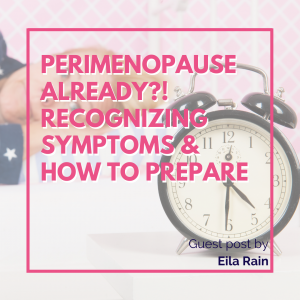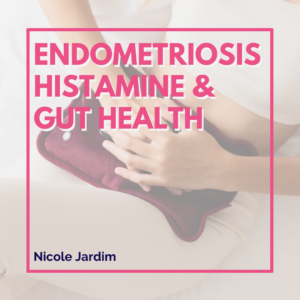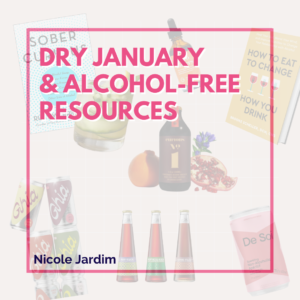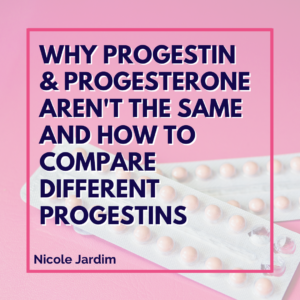Written by my Fall 2020 Apprenticeship Participant, Eila Rain. Interested in joining my next Apprenticeship? Sign up for the waitlist here.
When I was 30 years old, I heard the last thing I ever expected to hear from my doctor: my hormones resembled the body of a menopausal woman.
Oh, no thank you! I thought. I’m way too young for this!
At the time, I had just married my partner. As newlyweds with no children, we were devastated.
But the truth was that I had known something wasn’t right with my body for some time.
My periods were heavier and more painful than ever before. Despite exercising and eating healthy, my body was storing weight in my belly and hips. I’d also lost my sex drive, which was unfortunate for being a young couple.
As stressful as this day was, it also changed my life.
I personally believed that my symptoms were dietary and lifestyle-driven, so I made it my mission to learn everything possible about nutrition, hormones, menstrual cycles, and ultimately, the root cause of my woes—restoring my health naturally.
Fast forward to one year later…I was symptom-free and my hormones were back in optimal ranges.
No more signs of menopause for me, thank goodness!
What is Menopause vs Perimenopause?
We all hear stories of women suffering through the transition leading up to menopause, but many don’t know what this period is called. Meet Ms. Perimenopause, Ladies!
Perimenopause is the period when hormones are no longer regular as one begins transitioning toward menopause. Menopause is only ONE day of your life and is reached once there is NO menstrual flow for 12 consecutive months.
Essentially, perimenopause is everything leading up to that day.
So, how do you know perimenopause has arrived?
Signs of Perimenopause
Depending on the person, perimenopause can begin 10-15 years before officially reaching menopause. Being aware of potential signs in your 30s and 40s will keep you ahead of the game!
According to Dr. Jerilynn Prior (professor of endocrinology at the University of British Columbia), a menstruating middle-aged woman who experiences at least three of the signs mentioned below can be diagnosed as perimenopausal:
- New swollen, sore, lumpy breasts
- Periods are no longer like “clockwork”
- Increased cramps
- Increased PMS and mood swings
- Onset of heavier periods
- New mid-sleep waking
- Night sweats
- Hot flashes
- Noticeable weight gain
- Onset or worsening of migraines
Understanding Hormonal Changes During Perimenopause
Without getting too scientific, it’s important to understand how hormonal changes, specifically in regards to estrogen, affect perimenopausal women.
Perimenopause was previously believed to involve low estrogen levels. But the truth is, studies show that estrogen levels actually rise (an average of 30% higher) and become unstable before menopause—when they settle into stable, lower levels.
In perimenopause, progesterone levels become insufficient and even nonexistent, leading to relative estrogen dominance.
How To Know If You’re Too Estrogen Dominant
When estrogen to progesterone becomes imbalanced, perimenopausal women easily become estrogen dominant. You might experience:
- Swollen, sore, lumpy breasts
- Fibroids or ovarian cysts
- Fertility struggles or miscarriages
- Heavy, flooding periods
- Shortened cycles (bleeding every 2-3 weeks)
- Painful periods
- Headaches/migraines
- Feelings of depression
- Low sex drive
- Feeling exhausted all the time
- Anxiety
- Brain fog & memory issues
- Hot flashes or night sweats
- Changes in sleep
- Thyroid disorders
- Hair thinning
- Autoimmunity
- Unexplained weight gain
Natural Approaches to Rebalancing Estrogen
Perimenopause symptoms are not necessarily an inevitable part of life, but a result of our modern-day diet, environment, and lifestyle. Luckily, there are things in our control to rebalance estrogen and feel more like ourselves again.
Here are some things to watch out for:
- Reduce Exposure To Xenoestrogens
Xenoestrogens are one of the primary contributors to estrogen dominance. These external types of estrogen-mimicking chemicals interfere with your natural estrogen balance AND sadly, they are SUPER common in our environment. You’d be shocked at how many items in your home contain these hormone-disrupting chemicals!
To avoid xenoestrogens:
- Eat organic to reduce exposure. (Food containing chemicals like herbicides, pesticides, insecticides, and preservatives or additives are a big no-no!).
- Eat only pasture-raised organic meats and wild-caught seafood.
- Watch out for toxins in beauty care products.
- Use natural household cleaners.
- Use safe cookware such as glass, ceramic and stainless steel. Get rid of non-stick pans.
- Say goodbye to plastic! Avoid drinking from plastic bottles or heating foods in plastic.
- Up Your Liver-Loving Nutrients
Did you know that your liver works around the clock to clean your blood and remove excess estrogen? Give your liver some love in return for its hard efforts.
(This is also why I start 90% of my clients on my signature cleanse protocol which is like giving your liver new life.)
To detoxify estrogen and help the body rebalance, your liver needs:
- Vitamin B6, B12, and folate
- Zinc
- Selenium
- Magnesium
- Protein
Tip: Be careful with those happy hours––just one alcoholic beverage per day is shown to raise your blood level of estrogen.
- Eat More DIM
Cruciferous vegetables like kale, brussels sprouts, cabbage, and broccoli are nutrient powerhouses that support our bodies in metabolizing diindolylmethane, or DIM, for short. The kale hype is real, my friends!
DIM is amazing for estrogen-related problems by modulating estrogen metabolism and detoxification.
According to Dr. Amy Myers, M.D, estrogen is metabolized by the liver through three different pathways. Depending on the pathway, estrogen will be converted into “good” or “bad” metabolites. Good estrogen metabolites help maintain healthy breast tissue, balance moods, and increase sex drive, while bad estrogen metabolites contribute to weight gain, candida, autoimmune disease, and certain cancers.
Long story short: Eating DIM is a safe and natural way to support healthy estrogen metabolism and protect yourself!
As far as which veggies to eat, choose from:
- Cauliflower
- Red and green cabbage
- Bok choy
- Arugula
- Radishes
- Kale
- Collard greens
- Mustard greens
- Turnips
- Brussel sprouts
- Broccoli
Now that you know the symptoms are often rooted in estrogen dominance, you can support your body to rebalance. Remember, if you’re experiencing symptoms of perimenopause, paying more attention to your diet and lifestyle can be one of the most rewarding changes you make.
You got this!
Sources
1: https://www.ncbi.nlm.nih.gov/pmc/articles/PMC3987489/
2: https://www.amymyersmd.com/article/estrogen-dominance-causes/
3: https://academic.oup.com/alcalc/article/35/5/417/206575
About Eila

Eila is a certified Integrative Nutrition Practitioner working with women globally to balance their hormones. She is particularly skilled at helping women achieve symptom-free menstrual cycles, alleviate perimenopause symptoms, manage PCOS, optimize fertility, and address the root cause of weight gain and fatigue. Her all-natural approach is proven effective and is highly desirable for women who prefer to avoid drugs or surgery and instead address the underlying cause. You can connect with Eila here, or on her Instagram @eilarainhealth.



